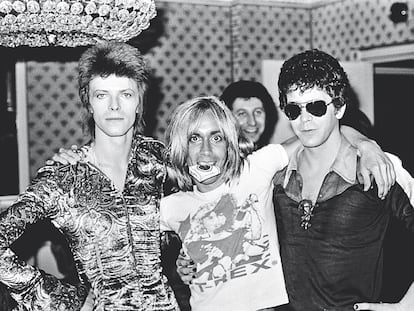Your song stinks: How we judge music for reasons that have nothing to do with quality
Does popular equal good, or is it precisely the opposite? The answer lies between the fans, the critics and the eye of the beholder

Nothing good has been said about Pink’s new song, Never Gonna Not Dance Again, penned by today’s most successful producer and songwriter, Swedish Max Martin (author of 25 number-one hits in the US). “Lifeless,” “generic,” “tragic” and “horrible” are some of the adjectives that can be found in PopJustice, the most respected specialized pop website. And yes, it is weak and bland, but it is also catchy. One could argue that it is what most people look for in pop music. Hence the question: why are songs that fulfill their purpose, that satisfy the audience they are addressed to, considered bad? Some usual opinions come with this label: the lyrics are way too corny (or obvious, or cryptic) and the music, when it is too catchy or sappy, reveals its flaws.
Pink, who will release a new album in February, is an example of a mass phenomenon that leaves the critics unimpressed. Marta España, musicologist, music critic and leader of Marta Movidas, her own musical project, stresses the influence of the “relatability factor” on the way we assess music: “Oftentimes, people define themselves by the music they consume, but also by what they publicly decide not to consume,” she explains. “In this way, they reveal the ideals, values and behaviors that are linked to a genre they share. We often categorize a song [and an artist] by what it means to a society, even if it is unconsciously, and that makes you like it or not.”
Sebas E. Alonso, director of the independent music website Jenesaispop and author of the book 200 discos clave del siglo XXI (200 Key Records of the 21st Century), is very clear that the popularity of a song does not determine its quality. “The complexity of the lyrics, the originality of the subject matter, its point of view or its social relevance [...] can contribute. That a song is catchy or commercial does not make it good or bad. In the end, for me, at least in pop, almost everything is melody and hooks.” Alonso points out that some songs are actually created to annoy, like Taylor Swift’s Look What You Made Me Do, which he considered bad until he realized that “the melody used in the chorus consists of a single note, which for the artist is an identity trait. It is done on purpose.” The song is “about hate,” and its repetitive, tiresome sound is intentional.
Despite the passion with which we defend a good song or attack a bad one, despite the conviction with which we defend our ideas, the only certainty is that we act subjectively. “I don’t think there are good or bad songs,” adds España. “There is a canon and a historical construct around which Western popular music has been governed. Reggaeton, for example, doesn’t follow the Western canonical principles [...] and for this reason it is considered a bad product by many people.”
Thus, there is no consensus on what is good or bad, not even within music criticism: “Something that a heavy metal magazine deems a masterpiece won’t even be mentioned in a publication about electronic music,” says Alonso. “There isn’t even a consensus on Queen’s Bohemian Rhapsody. Some consider it a sublime piece and others see it as tacky.” However, he points out, music criticism also operates within a series of aesthetic conventions that are accepted at a given time or space, and the specialized media recommend music that either adheres to those conventions or threatens them. However, the fact that subjectivity prevails, the journalist believes, “doesn’t mean that it is not interesting to listen to argued and justified opinions, which is what music criticism tries to do.” In the same vein, “the fact that everything is subjective does not mean that all opinions are interesting or contribute something.”
Popularity killed pop
History has produced many examples that confirm that a song is usually considered “bad” after it reaches a massive level of popularity, even if the composition of the song itself (melody, harmony, rhythm, voice and lyrics) comply with some established rules that make it “good.” In 2016, TIME magazine chose Justin Timberlake’s Can’t Stop the Feeling as the worst song of the year. This nice and harmless disco-pop composition was also the most commercially successful song of that year. Why does a prestigious media outlet like TIME declare that the most successful song of 2016 was, at the same time, the worst? Alonso believes that TIME would not have given that distinction to “a song that nobody knows, because nobody would read the article.” He believes that it was a victim of its own popularity. At the same time, he partially agrees with TIME, because “the song is really basic” and “it may cross the line of the obvious, since the word ‘dance’ appears about 40 times.”
The way certain songs are analyzed in the media is also influenced by factors that go beyond the strictly musical, such as sexist or racist biases which, in some cases, help shape the musical canon itself. “Rihanna, Beyoncé, all the pop divas… they’ve never been considered cult artists. On the other hand, Kanye West is a genius,” argues España. “Of course, sexism influences when establishing a canon, but so does class, race… In the ‘best of the year’ lists, almost all the artists are European or American. Today, more than ever, globalization is allowing this canon to expand to other territories.”
Another victim of his own success (and of pop) is British singer Rick Astley. His hit Never Gonna Give You Up is one of the most iconic pop songs of the 1980s, but it also became something akin to the internet’s first meme. According to Stereogum columnist Tom Breihan, the song is simply “bad,” despite the huge success it enjoyed in its day (it was #1 in 25 countries in 1987) as well as its current durability. For Breihan, Never Gonna Give You Up is the “shallowest Motown pastiche you’re ever going to hear.” The video completes the joke, because as much as it seems like a parody of the videos of the 1980s, it is not. Which brings us to another tricky variable in music criticism: judging the songs of the past today.
“I don’t think it’s a bad song at all,” says Alonso. “Entire essays and books have been written about its authors, Stock Aitken & Waterman. Today, they are well regarded and recognized by media outlets like The Guardian.” España reflects: “Songs that reach number one or go viral should not be underestimated. Of course, when you enter that industry, the infrastructure around you leads to more favorable numbers that the underground seldom can reach. However,” she points out, “you can tell that there are people who know a lot about music behind all that.”
The journalist believes that “labeling something as bad just because it is very massive is very dangerous.” She does not rule out that this attitude could stem from an elitist perspective, because “not everyone has the same access to culture, and labeling something as bad just because it is part of mass culture is classist,” she says. “There are many types of music, and each of them responds to a specific social function.”
Love, love, love
One of the reasons why Never Gonna Give You Up is mocked are its sappy lyrics. In it, Astley promises his lover: “Never gonna give you up, never gonna let you down, never gonna run around and desert you; never gonna make you cry, never gonna say goodbye, never gonna tell a lie and hurt you.” It could be seen as medieval courtly love, applied to pop. The critics don’t like that sappiness, and tend to ignore excessively sentimental releases.
In the book Let’s Talk About Love: A Journey to the End of Taste, Carl Wilson focuses on Céline Dion – a singer that has been historically reviled by the specialized music media – to explore how sentimentality has always been considered in poor taste. España calls this into question: “All songs are sentimental, aren’t they? Most of them talk about feelings. I believe that everything lies, again, in the concept of authenticity. That is to say, the current music critic comes and says that they don’t go for the sentimentality of one group, but another group’s is OK; but usually, more than the song itself, that opinion derives from an artist’s career, whether they compose their own songs, and also from the aesthetics of the moment. The concept of ‘tasteless’ was completely different 10 years ago.”
Alonso shares a similar opinion and recommends Let’s Talk About Love: “The book says that everything we consider pretty or ugly is but a social convention that belongs to a specific time and place. A song that says ‘I love you,’ just like that, will have no further value, obviously. But in the end, the artist’s performance, the melody... they can make even the dumbest thing work. The singer from The 1975 says we’ve become overly cynical with the world of underground music, and he’s absolutely right.”
In fact, underground and commercial music are closely related out of necessity. “It’s very important that music criticism remains within the underground, because otherwise popular music would absorb all alternative spaces,” argues España. “However, the popular and the underground are constantly feeding off each other: the underground dictates the trends of the future, and then the industry appropriates and capitalizes on them. For the music critics, in most cases, trends are only authentic when they have not caught on, that is, before they become popular.”
It is too soon to tell whether Pink has released a candidate for the worst song of 2022 or not, but probably nobody cares less than her – and her millions of fans.
Tu suscripción se está usando en otro dispositivo
¿Quieres añadir otro usuario a tu suscripción?
Si continúas leyendo en este dispositivo, no se podrá leer en el otro.
FlechaTu suscripción se está usando en otro dispositivo y solo puedes acceder a EL PAÍS desde un dispositivo a la vez.
Si quieres compartir tu cuenta, cambia tu suscripción a la modalidad Premium, así podrás añadir otro usuario. Cada uno accederá con su propia cuenta de email, lo que os permitirá personalizar vuestra experiencia en EL PAÍS.
¿Tienes una suscripción de empresa? Accede aquí para contratar más cuentas.
En el caso de no saber quién está usando tu cuenta, te recomendamos cambiar tu contraseña aquí.
Si decides continuar compartiendo tu cuenta, este mensaje se mostrará en tu dispositivo y en el de la otra persona que está usando tu cuenta de forma indefinida, afectando a tu experiencia de lectura. Puedes consultar aquí los términos y condiciones de la suscripción digital.
More information
Últimas noticias
Mexico’s missing people crisis casts a shadow over World Cup venue
Helen Levitt, the photographer who captured the theater of the everyday
The guardians of the meteorites of the Argentine Chaco
Families demand repatriation of bodies of Colombians who died in Ukraine: ‘This war is a slaughterhouse for foreigners’
Most viewed
- Christian Louboutin: ‘Young people don’t want to be like their parents. And if their parents wear sneakers, they’re going to look for something else’
- US sanctions against jailed cartel leader ‘El Marro’ highlight Mexico’s lack of control over its prisons
- Cartels in Mexico take a leap forward with narco-drones: ‘It is criminal groups that are leading the innovation race’
- Liset Menéndez de la Prida, neuroscientist: ‘It’s not normal to constantly seek pleasure; it’s important to be bored, to be calm’
- ‘El Limones’ and the growing union disguise of Mexican organized crime










































